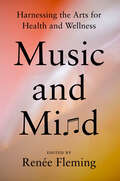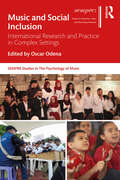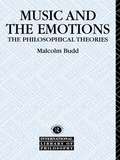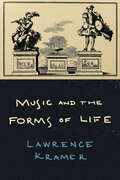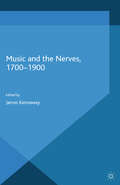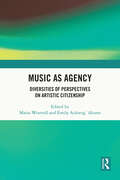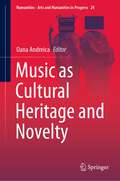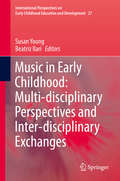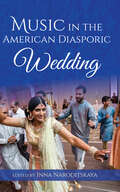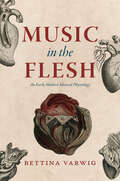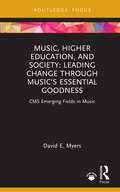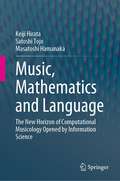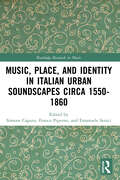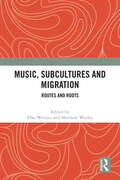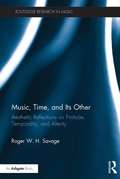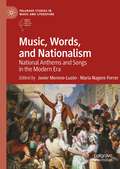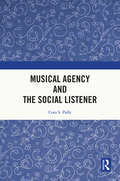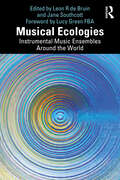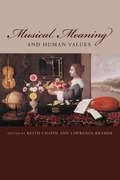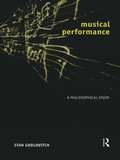- Table View
- List View
Music and Mind: Harnessing the Arts for Health and Wellness
by Edited by Renée Fleming"This book inspires us all to immerse ourselves in the vast potential of music and other creative arts to heal our wounds, sharpen our minds, enliven our bodies, and restore our broken connections.&” —Bessel van der Kolk, #1 New York Times bestselling author of The Body Keeps the ScoreWorld-renowned soprano and arts/health advocate Renée Fleming curates a collection of essays from leading scientists, artists, creative arts therapists, educators, and healthcare providers about the powerful impacts of music and the arts on health and the human experienceChapters include: Ann Patchett, &“How to Fall in Love with Opera&” Yo-Yo Ma, &“Nature, Culture, and Healing&”Aniruddh D. Patel, &“Musicality, Evolution, and Animal Responses to Music&”Richard Powers, &“The Parting Glass"Daniel J. Levitin, &“What Does It Mean to be Musical?&” Anna Deavere Smith, &“Healing Arts&” Rosanne Cash, &“Rabbit Hole&” Rhiannon Giddens, &“How Music Shows Us What It Means to Be Human&”Robert Zatorre, &“Musical Enjoyment and the Reward Circuits of the Brain&”Concetta Tomaino, &“Music and Memory&”A compelling and growing body of research has shown music and arts therapies to be effective tools for addressing a widening array of conditions, from providing pain relief andalleviating anxiety and depression to regaining speech after stroke or traumatic brain injury, and improving mobility for people with disorders that include Parkinson&’s disease and MS.In Music and Mind Renée Fleming draws upon her own experience as an advocate to showcase the breadth of this booming field, inviting leading experts to share their discoveries. In addition to describing therapeutic benefits, the book explores evolution, brain function, childhood development, and technology as applied to arts and health.Much of this area of study is relatively new, made possible by recent advances in brain imaging, and supported by theNational Institutes of Health, major hospitals, and universities. This work is sparking an explosion of public interest in the arts and health sector.Fleming has presented on this material in over fifty cities across North America, Europe, and Asia, collaborating with leading researchers, policy-makers, and practitioners. With essays from notable musicians, writers, and artists, as well as leading neuroscientists, Music and Mind is a groundbreaking book, the perfect introduction and overview of this exciting new field.
Music and Philosophy in the Roman Empire
by Francesco Pelosi Federico M. PetrucciIs music just matter of hearing and producing notes? And is it of interest just to musicians? By exploring different authors and philosophical trends of the Roman Empire, from Philo of Alexandria to Alexander of Aphrodisias, from the rebirth of Platonism with Plutarch to the last Neoplatonists, this book sheds light on different ways in which music and musical notions were made a crucial part of philosophical discourse. Far from being mere metaphors, notions such as harmony, concord and attunement became key philosophical tools in order to better grasp and conceptualise fundamental notions in philosophical debates from cosmology to ethics and from epistemology to theology. The volume is written by a distinguished international team of contributors.
Music and Social Inclusion: International Research and Practice in Complex Settings (SEMPRE Studies in The Psychology of Music)
by Oscar OdenaHow do we develop social inclusion through musical activities? What is the power of music in enhancing individual inclusion, group cohesion, and cross-community work in post-conflict environments? How can we investigate social music programmes and interventions? This comprehensive volume offers new research on these questions by an international team of experts from the fields of music education, music psychology, ethnomusicology, and community music. The book celebrates the rich diversity of ways in which learners of all ages participate in social music projects in complex settings. Contributions focus broadly on musical and social processes, considering its conceptualisation and practices in a number of contexts. The authors examine how social music projects can be fostered in complex settings, drawing examples from schools and community settings. These critical chapters will inspire readers to think deeply about social music interventions and their development. The book will be of crucial interest to educators, policymakers, researchers, and students, as it draws on applied research from across 14 countries, of which ten are in the Global South.
Music and the Emotions: The Philosophical Theories (International Library of Philosophy)
by Malcolm BuddIt has often been claimed, and frequently denied, that music derives some or all of its artistic value from the relation in which it stands to the emotions. This book presents and subjects to critical examination the chief theories about the relationship between the art of music and the emotions.
Music and the Forms of Life
by Lawrence KramerInventors in the age of the Enlightenment created lifelike androids capable of playing music on real instruments. Music and the Forms of Life examines the link between such simulated life and music, which began in the era's scientific literature and extended into a series of famous musical works by Haydn, Mozart, and Beethoven. Music invented auditory metaphors for the scientific elements of life (drive, pulse, sensibility, irritability, even metabolism), investigated the affinities and antagonisms between life and mechanism, and explored questions of whether and how mechanisms can come to life. The resulting changes in the conceptions of both life and music had wide cultural resonance at the time, and those concepts continued to evolve long after. A critical part of that evolution was a nineteenth-century shift in focus from moving androids to the projection of life in motion, culminating in the invention of cinema. Weaving together cultural and musical practices, Lawrence Kramer traces these developments through a collection of case studies ranging from classical symphonies to modernist projections of waltzing specters by Mahler and Ravel to a novel linking Bach's Goldberg Variations to the genetic code.
Music and the Nerves, 1700-1900
by James KennawayThe relationship between music and the nervous system is now the subject of intense interest for scientists and people in the humanities, but this is by no means a new phenomenon. This volume sets out the history of the relationship between neurology and music, putting the advances of our era into context.
Music as Agency: Diversities of Perspectives on Artistic Citizenship
by Emily Achieng’ Akuno Maria WestvallMusic as Agency: Diversities of Perspectives on Artistic Citizenship focuses on the concept, application, interpretation and manifestation of Artistic Citizenship in diverse contexts. The key concepts that the book tackles are: Cultural experience, artistic practice, musical identities, equity, democracy, community, activism, resistance and empathy.In giving an overview of aspects of the compound concept of artistic citizenship, Akuno and Westvall present the outcome of research and interrogation of practice by a global network of educator-researchers from Africa, the Americas, Asia and Europe. The book articulates notions of artistic citizenship, coming up with the term artizenship as a derivative of the composite term. It further explains and analyses practical ways of perceiving and relating to art spaces, art practices and arts objects towards belonging, being and becoming in a global space that is disparate, polarised and often alienating, and thus responding to issues such as social justice, identity, participation and inclusion. With a focus on music, the book targets musicians, scholars, educators and enthusiasts keen on gaining a deeper understanding of how music and musicking can influence human interactions towards social integration, trust, cultural awareness and intercultural understanding.
Music as Cultural Heritage and Novelty (Numanities - Arts and Humanities in Progress #24)
by Oana AndreicaThis book provides a multifaceted view on the relation between the old and the new in music, between tradition and innovation. This is a much-debated issue, generating various ideas and theories, which rarely come to unanimous conclusions. Therefore, the book offers diverse perspectives on topics such as national identities, narrative strategies, the question of musical performance and musical meaning. Alongside themes of general interest, such as classical repertoire, the music of well-established composers and musical topics, the chapters of the book also touch on specific, but equally interesting subjects, like Brazilian traditions, Serbian and Romanian composers and the lullaby. While the book is mostly addressed to researchers, it can also be recommended to students in musicology, ethnomusicology, musical performance, and musical semiotics.
Music in Arts-Based Research and Depth Psychology: Listening for Shadow as Inclusive Inquiry (ISSN)
by Shara BrunThis book addresses an existing gap in academic arts-based research, whereby, rather than exploring music as an effective therapeutic intervention, it is explored as the central medium or tool of inquiry.Integrating heuristic, hermeneutic, and arts-based grounded theory methodologies, the book conceptualizes and describes the practice of Sonic Stretching as an in-depth example of using sound as an effective and systematic research tool. Stemming from evidence-based insights, the book explores and explains ways in which music and sound can be utilized in arts-based research (ABR) in all disciplines, as opposed to only being used among professional musicians and those operating within music studies. It points to some of the obstacles that have previously prevented this from happening more broadly and, in doing so, aims to help bridge the conspicuous gap in ABR studies, where music and sonic imagination should be.Offering a clear and well-presented example for integrating music and sound into processes of depth psychological inquiry and addressing the impact of colonialization upon embodied knowledge in music and academic research, it will appeal to scholars and researchers working at the intersection of psychology, music studies, education, social justice, and research methods.
Music in Early Childhood: Multi-disciplinary Perspectives And Inter-disciplinary Exchanges (International Perspectives on Early Childhood Education and Development #27)
by Susan Young Beatriz IlariThis book examines four main areas of music in early childhood: the traditions of music for young children, their capacities for music, the way they make music with others, and constructed and mediated musical childhoods. It studies several themes in detail, including music making in the home and family life, various musical experiences in schools, day cares, and the community at large in several locations around the globe. It looks at technology and diverse musical repertoires, as well as innovative pedagogies, children’s agency, and brain research. Expanding on the knowledge bases on which early childhood music education typically draws, the book brings together contributions from a range of authors from diverse fields such as education, psychology, sociology, cultural studies, anthropology, philosophy, ethnomusicology, and the neurosciences. The end result is a volume that offers a broad and contemporary picture of music in early childhood.
Music in the American Diasporic Wedding
by Edited by Inna NaroditskayaWith real-life stories, this collection “focuses on the role of music in the often-delicate negotiations surrounding weddings in immigrant communities” (Ellen Koskoff, author of A Feminist Ethnomusicology).Music in the American Diasporic Wedding explores the complex cultural adaptations, preservations, and fusions that occur in weddings between couples and families of diverse origins. Discussing weddings as a site of negotiations between generations, traditions, and religions, the essays gathered here argue that music is the mediating force between the young and the old, ritual and entertainment, and immigrant lore and assimilation.The contributors examine such colorful integrations as klezmer-tinged Mandarin tunes at a Jewish and Taiwanese American wedding, a wedding services industry in Chicago’s South Asian community featuring a diversity of wedding music options, and Puerto Rican cultural activists dancing down the aisles of New York’s St. Cecilia’s church to the thunder of drums and maracas and rapping their marriage vows. These essays show us what wedding music and performance tell us about complex multiethnic diasporic identities, and remind us that how we listen to and celebrate otherness defines who we are.
Music in the American Diasporic Wedding
by Edited by Inna NaroditskayaWith real-life stories, this collection “focuses on the role of music in the often-delicate negotiations surrounding weddings in immigrant communities” (Ellen Koskoff, author of A Feminist Ethnomusicology).Music in the American Diasporic Wedding explores the complex cultural adaptations, preservations, and fusions that occur in weddings between couples and families of diverse origins. Discussing weddings as a site of negotiations between generations, traditions, and religions, the essays gathered here argue that music is the mediating force between the young and the old, ritual and entertainment, and immigrant lore and assimilation.The contributors examine such colorful integrations as klezmer-tinged Mandarin tunes at a Jewish and Taiwanese American wedding, a wedding services industry in Chicago’s South Asian community featuring a diversity of wedding music options, and Puerto Rican cultural activists dancing down the aisles of New York’s St. Cecilia’s church to the thunder of drums and maracas and rapping their marriage vows. These essays show us what wedding music and performance tell us about complex multiethnic diasporic identities, and remind us that how we listen to and celebrate otherness defines who we are.
Music in the Flesh: An Early Modern Musical Physiology (New Material Histories of Music)
by Bettina VarwigA corporeal history of music-making in early modern Europe. Music in the Flesh reimagines the lived experiences of music-making subjects—composers, performers, listeners—in the long seventeenth century. There are countless historical testimonies of the powerful effects of music upon the early modern body; it is described as moving, ravishing, painful, dangerous, curative, and miraculous while affecting “the circulation of the humors, the purification of the blood, the dilation of the vessels and pores.” How were these early modern European bodies constituted that music generated such potent bodily-spiritual effects? Bettina Varwig argues that early modern music-making practices challenge our modern understanding of human nature as a mind-body dichotomy. Instead, they persistently affirm a more integrated anthropology, in which body, soul, and spirit remain inextricably entangled. Moving with ease across repertories and regions, sacred and vernacular musics, and domestic and public settings, Varwig sketches a “musical physiology” that is as historically illuminating as it is relevant for present-day performance. This book makes a significant contribution not just to the history of music, but also to the history of the body, the senses, and the emotions, revealing music as a unique access point for reimagining early modern modes of being-in-the-world.
Music in the works of Pythagoras of Samos and the Pythagoreans
by Juliano OzgaThe subject of this book, as per the title, is music (from the Greek μουσική τέχνη - musiké téchne, i.e. "the art of the muses") in the works of Pythagoras, the first intellectual in the history of Philosophy to make that art the center of their worldview, even including it in the so called "Exact Sciences". In order to have more comprehension and clarity with regards to the intellectual production of Pythagoras, whose written works survived to the 21st century in a very fragmented form and in much smaller number, it is necessary to research the historical sources contemporary to the philosopher, as well as those which succeeded him.
Music, Health and Wellbeing
by Brydie-Leigh Bartleet Naomi Sunderland Natalie Lewandowski Dan BendrupsThis book explores the power music has to address health inequalities and the social determinants of health and wellbeing. It examines music participation as a determinant of wellbeing and as a transformative tool to impact on wider social, cultural and environmental conditions. Uniquely, in this volume health and wellbeing outcomes are conceptualised on a continuum, with potential effects identified in relation to individual participants, their communities but also society at large. While arts therapy approaches have a clear place in the text, the emphasis is on music making outside of clinical contexts and the broader roles musicians, music facilitators and educators can play in enhancing wellbeing in a range of settings beyond the therapy room. This innovative edited collection will be of great interest to scholars and practitioners of music, social services, medical humanities, education and the broader health field in the social and medical sciences.
Music, Higher Education, and Society: Leading Change through Music’s Essential Goodness (CMS Emerging Fields in Music)
by David E. MyersThis volume asserts that institutional teaching, study, administration, and performance of music should derive from essential goodness: the transcendent value embodied in meaning-making that is manifest through holistic cognitive, creative, kinesthetic, productive, and expressive reality.The classical music ecosystem suffers from a legacy of survival, rather than flourishing across increasingly diverse audiences among whom personal and shared meaning is the crux of perceived value. Myers calls for a renaissance in professional education and practice that embeds rigorous and disciplined adherence to essential goodness as a non-negotiable premise. Change leadership is essential if classical music and musicians are to offer society the value it deserves through the classical arts, and administrators, boards, funders, and artists must adopt attitudes of service to this greater good in order to invite and lead participatory, co-creative engagement. Through critical analysis of the longstanding status quo, Myers offers powerful suggestions for change beginning in higher education and flowing through applications across society.Contextualizing music higher education within wider ecosystems of teaching and practice, this book shows how leaders can embrace strategic change as a positive opportunity and offers new models for addressing contemporary challenges in a mission-driven way, including preparing musicians for careers and engaging communities.
Music, Mathematics and Language: The New Horizon of Computational Musicology Opened by Information Science
by Satoshi Tojo Keiji Hirata Masatoshi HamanakaThis book presents a new approach to computational musicology in which music becomes a computational entity based on human cognition, allowing us to calculate music like numbers. Does music have semantics? Can the meaning of music be revealed using symbols and described using language? The authors seek to answer these questions in order to reveal the essence of music. Chapter 1 addresses a very fundamental point, the meaning of music, while referring to semiotics, gestalt, Schenkerian analysis and cognitive reality. Chapter 2 considers why the 12-tone equal temperament came to be prevalent. This chapter serves as an introduction to the mathematical definition of harmony, which concerns the ratios of frequency in tonic waves. Chapter 3, “Music and Language,” explains the fundamentals of grammar theory and the compositionality principle, which states that the semantics of a sentence can be composed in parallel to its syntactic structure. In turn, Chapter 4 explains the most prevalent score notation – the Berklee method, which originated at the Berklee School of Music in Boston – from a different point of view, namely, symbolic computation based on music theory. Chapters 5 and 6 introduce readers to two important theories, the implication-realization model and generative theory of tonal music (GTTM), and explain the essence of these theories, also from a computational standpoint. The authors seek to reinterpret these theories, aiming at their formalization and implementation on a computer. Chapter 7 presents the outcomes of this attempt, describing the framework that the authors have developed, in which music is formalized and becomes computable. Chapters 8 and 9 are devoted to GTTM analyzers and the applications of GTTM. Lastly, Chapter 10 discusses the future of music in connection with computation and artificial intelligence.This book is intended both for general readers who are interested in music, and scientists whose research focuses on music information processing. In order to make the content as accessible as possible, each chapter is self-contained.
Music, Place, and Identity in Italian Urban Soundscapes circa 1550-1860 (Routledge Research in Music)
by Emanuele Senici Simone Caputo Franco PipernoMusic, Place, and Identity in Italian Urban Soundscapes circa 1550-1860 presents new perspectives on the role music played in the physical, cultural, and civic spaces of Italian cities from the sixteenth to the nineteenth century. Across thirteen chapters, contributors explore the complex connections between sound and space within these urban contexts, demonstrating how music and sound were intimately connected to changing social and political practices. The volume offers a critical redefinition of the core concept of soundscape, considering musical practices through the lenses of territory, space, representation, and identity, in five parts: Soundscape, Phonosphere, and Urban History Urban Soundscapes across Time Urban Soundscapes and Acoustic Communities Urban Soundscapes in Literary Sources Reconstructing Urban Soundscapes in the Digital Era Music, Place, and Identity in Italian Urban Soundscapes circa 1550-1860 reframes our understanding of Italian music history beyond models of patronage, investigating how sounds and musics have contributed to the construction of human identities and communities.
Music, Subcultures and Migration: Routes and Roots
by Matthew Worley Elke WeesjesThis edited volume concentrates on the period from the 1940s to the present, exploring how popular music forms such as blues, disco, reggae, hip hop, grime, metal and punk evolved and transformed as they traversed time and space. Within this framework, the collection traces how music and subcultures travel through, to and from democracies, autocracies and anocracies.The chosen approach is multidisciplinary and deliberately diverse. Using both archival sources and oral testimony from a wide variety of musicians, promoters, critics and members of the audience, contributors from a range of academic disciplines explore music and subcultural forms in countries across Asia, Europe, Oceania, North America and Africa. They investigate how far the meaning of music and associated subcultures change as they move from one context to another and consider whether they transcend or blur parameters of class, race, gender and sexuality.
Music, Time, and Its Other: Aesthetic Reflections on Finitude, Temporality, and Alterity (Routledge Research in Music)
by Roger W. SavageMusic, Time, and Its Other explores the relation between the enigmatic character of our temporal experiences and music’s affective power. By taking account of competing concepts of time, Savage explains how music refigures dimensions of our experiences through staking out the borderlines between time and eternity. He examines a range of musical expressions that reply to the deficiency born from the difference between time and an order that exceeds or surpasses it and reveals how affective tonalities of works by Bach, Carolan, Debussy, Schoenberg, Messiaen, and Glass augment our understanding of our temporal condition. Reflections on the moods and feelings to which music gives voice counterpoint philosophical investigations into the relation between music’s power to affect us and the force that the present has with respect to the initiatives we take. Music, Time, and Its Other thus sets out a new approach to music, aesthetics, politics, and the critical roles of judgment and imagination.
Music, Words, and Nationalism: National Anthems and Songs in the Modern Era (Palgrave Studies in Music and Literature)
by Javier Moreno-Luzón María Nagore-FerrerMusic, Words and Nationalism: National Anthems and Songs in the Modern Era considers the concept of nationalism from 1780 to 2020 through anthems and national songs as symbolic and representative elements of the national identity of individuals, peoples, or collectivities. The volume shows that both the words and music of these works reveal a great deal about the defining features of a nation, its political and cultural history, and its self-perception. The book takes an interdisciplinary approach that provides a better understanding of the role of national anthems and songs in the expression of national identities and nationalistic goals. From this perspective, the relationship between hymns and political contexts, their own symbolic content (both literary and musical) and the role of specific hymns in the construction of national sentiments are surveyed.
Musical Agency and the Social Listener
by Cora S. PalfyMusic as a narrative drama is an intriguing idea, which has captured explicit music theoretical attention since the nineteenth century. Investigations into narrative characters or personae has evolved into a sub-field—musical agency. In this book, Palfy contends that music has the potential to engage us in social processes and that those processes can be experienced as a social interaction with a musical agent. She explores the overlap between the psychological processes in which we participate in order to understand and engage with people, and those we engage in when we listen to music. Thinking of musical agency as a form of social process is quite different from existing theoretical frameworks for agency. It implies that we come to musical analysis by way of intuition—that our ideas are already partially formed based on our experience of the piece (and what it makes us feel or how it makes us sense it as any other) when we choose to analyze and interpret it. Palfy’s focus on social processes is a very effective way to pinpoint when and why it is that our attention is captured and engaged by musical agents.
Musical Ecologies: Instrumental Music Ensembles Around the World
by Jane Southcott de Bruin, Leon RCommunity music around the world reflects the growing and diverse ways humans collectivise and express themselves in ways that articulate our cultural, social, and environmental complexity. Revisiting, redevising, and reimagining some of the field’s approaches, ideologies, and contexts, this co-edited volume investigates beyond generalist intercultural and internationalist concepts to reveal the complexity of social ways people come together to make music and to making music be central to this sociality.The authors explore the role community music plays out around the world and how various instrumentally based music-making communities operate as ecologies that allow notions of social, political, and cultural agency and identity/ies. Chapters cover various instrumental community music ensembles, observing how they, as social microcosms of change and stasis, provide working methods new and old, extol values, and model ethical behaviours that are fluid and dynamic, steadfast and unyielding, and that contribute to the ebb and flow of people and their agency that remains under-researched. Insights are provided on variously functioning ensembles throughout the world, showing how myriad instrumental music communities act as drivers, complex environments, and apparati for musical and social expression that accommodates the musical aspirations of their members.Taken as a whole, this book explores community music as local, glocal, global phenomena, critically discussing the redefinition of community music and what music-making means to people in the twenty-first century.
Musical Meaning and Human Values
by Lawrence Kramer Keith ChapinMusical understanding has evolved dramatically in recent years, principally through a heightened appreciation of musical meaning in its social, cultural, and philosophical dimensions. This collection of essays by leading scholars addresses an aspect of meaning that has not yet received its due: the relation of meaning in this broad humanistic sense to the shaping of fundamental values. The volume examines the open and active circle between the values and valuations placed on music by both individuals and societies, and the discovery, through music, of what and how to value.With a combination of cultural criticism and close readings of musical works, the contributors demonstrate repeatedly that to make music is also to make value, in every sense. They give particular attention to values that have historically enabled music to assume a formative role in human societies: to foster practices of contemplation, fantasy, and irony; to explore sexuality, subjectivity, and the uncanny; and to articulate longings for unity with nature and for moral certainty. Each essay in the collection shows, in its own way, how music may provoke transformative reflection in its listeners and thus help guide humanity to its own essential embodiment in the world.The range of topics is broad and developed with an eye both to the historical specificity of values and to the variety of their possible incarnations. The music is both canonical and noncanonical, old and new. Although all of it is “classical,” the contributors’ treatment of it yields conclusions that apply well beyond the classical sphere. The composers discussed include Gabrieli, Marenzio, Haydn, Beethoven, Mendelssohn, Brahms, Wagner, Puccini, Hindemith, Schreker, and Henze.Anyone interested in music as it is studied today will find this volume essential reading.
Musical Performance: A Philosophical Study
by Stan GodlovitchMost music we hear comes to us via a recording medium on which sound has been stored. Such remoteness of music heard from music made has become so commonplace it is rarely considered. Musical Performance: A Philosophical Study considers the implications of this separation for live musical performance and music-making. Rather than examining the composition or perception of music as most philosophical accounts of music do, Stan Godlovitch takes up the problem of how the tradition of active music playing and performing has been challenged by technology and what problems this poses for philosophical aesthetics. Where does does the value of musical performance lie? Is human performance of music a mere transfer medium? Is the performance of music more expressive than recorded music? Musical Performance poses questions such as these to develop a fascinating account of music today. musicians - but via some recording medium on which sound has been stored.
